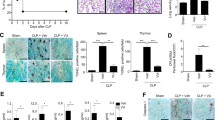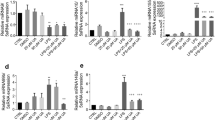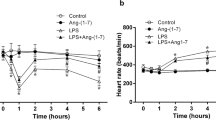Abstract
Approaches for controlling inflammatory responses and reducing the mortality rate of septic patients remain clinically ineffective; new drugs need to be identified that can induce anti-inflammatory responses. Ephedrine hydrochloride (EH) is a compound that is widely used in cardiovascular diseases, especially to treat hypotension caused by either anesthesia or overdose of antihypertensive drugs. In this study, we reported that EH also plays an important role in the control of the inflammatory response. EH increased IL-10 and decreased proinflammatory cytokine (IL-6, tumor-necrosis factor (TNF)-α, IL-12 and IL-1β) expression in primary peritoneal macrophages and Raw264.7 cells treated with peptidoglycan (PGN), a Gram-positive cell wall component. The anti-inflammatory role of EH was also demonstrated in an experimental mouse model of peritonitis induced by intraperitoneal PGN injection. The phosphatidylinositol 3-kinase (PI3K)/Akt pathway was found to be responsible for the EH-mediated increase in IL-10 production and decrease in IL-6 expression. Therefore, our results illustrated that EH can help maintain immune equilibrium and diminish host damage by balancing the production of pro- and anti-inflammatory cytokines after PGN challenge. EH may be a new potential anti-inflammatory drug that can be useful for treating severe invasive Gram-positive bacterial infection.
This is a preview of subscription content, access via your institution
Access options
Subscribe to this journal
Receive 12 digital issues and online access to articles
$119.00 per year
only $9.92 per issue
Buy this article
- Purchase on Springer Link
- Instant access to full article PDF
Prices may be subject to local taxes which are calculated during checkout






Similar content being viewed by others
References
Martin GS, Mannino DM, Eaton S, Moss M . The epidemiology of sepsis in the United States from 1979 through 2000. N Engl J Med 2003; 348: 1546–1554.
Prabhakara R, Harro JM, Leid JG, Keegan AD, Prior ML, Shirtliff ME . Suppression of the inflammatory immune response prevents the development of chronic biofilm infection due to methicillin-resistant Staphylococcus aureus. Infect Immun 2011; 79: 5010–5018.
Sigel S, Bunk S, Meergans T, Doninger B, Stich K, Stulnig T et al. Apolipoprotein B100 is a suppressor of Staphylococcus aureus-induced innate immune responses in humans and mice. Eur J Immunol 2012; 42: 2983–2989.
O'Neill LA, Bowie AG . The family of five: TIR-domain-containing adaptors in Toll-like receptor signalling. Nat Rev Immunol 2007; 7: 353–364.
Andraws R, Chawla P, Brown DL . Cardiovascular effects of ephedra alkaloids: a comprehensive review. Prog Cardiovasc Dis 2005; 47: 217–225.
Zheng Y, Guo Z, He W, Yang Y, Li Y, Zheng A et al. Ephedrine hydrochloride protects mice from LPS challenge by promoting IL-10 secretion and inhibiting proinflammatory cytokines. Int Immunopharmacol 2012; 13: 46–53.
Zheng Y, An H, Yao M, Hou J, Yu Y, Feng G et al. Scaffolding adaptor protein Gab1 is required for TLR3/4- and RIG-I-mediated production of proinflammatory cytokines and type I IFN in macrophages. J Immunol 2010; 184: 6447–6456.
Liu X, Zhan Z, Li D, Xu L, Ma F, Zhang P et al. Intracellular MHC class II molecules promote TLR-triggered innate immune responses by maintaining activation of the kinase Btk. Nat Immunol 2011; 12: 416–424.
Xu S, Liu X, Bao Y, Zhu X, Han C, Zhang P et al. Constitutive MHC class I molecules negatively regulate TLR-triggered inflammatory responses via the Fps-SHP-2 pathway. Nat Immunol 2012; 13: 551–559.
Li L, Whiteman M, Moore PK . Dexamethasone inhibits lipopolysaccharide-induced hydrogen sulphide biosynthesis in intact cells and in an animal model of endotoxic shock. J Cell Mol Med 2009; 13: 2684–2692.
Smallie T, Ricchetti G, Horwood NJ, Feldmann M, Clark AR, Williams LM . IL-10 inhibits transcription elongation of the human TNF gene in primary macrophages. J Exp Med 2010; 207: 2081–2088.
Saraiva M, O'Garra A . The regulation of IL-10 production by immune cells. Nat Rev Immunol 2010; 10: 170–181.
Akira S, Uematsu S, Takeuchi O . Pathogen recognition and innate immunity. Cell 2006; 124: 783–801.
Mullaly SC, Kubes P . The role of TLR2 in vivo following challenge with Staphylococcus aureus and prototypic ligands. J Immunol 2006; 177: 8154–8163.
Tuluc F, Meshki J, Kunapuli SP . Membrane lipid microdomains differentially regulate intracellular signaling events in human neutrophils. Int Immunopharmacol 2003; 3: 1775–1790.
Fry DE . Sepsis, systemic inflammatory response, and multiple organ dysfunction: the mystery continues. Am Surg 2012; 78: 1–8.
Wang W, Lim J, Li J . Synergistic and feedback signaling mechanisms in the regulation of inflammation in respiratory infections. Cell Mol Immunol 2012; 9: 131–135.
Leon LR, White AA, Kluger MJ . Role of IL-6 and TNF in thermoregulation and survival during sepsis in mice. Am J Physiol 1998; 275: R269–R277.
Geppert A, Steiner A, Zorn G, Delle-Karth G, Koreny M, Haumer M et al. Multiple organ failure in patients with cardiogenic shock is associated with high plasma levels of interleukin-6. Crit Care Med 2002; 30: 1987–1994.
Giamarellos-Bourboulis EJ, Bolanos N, Laoutaris G, Papadakis V, Koussoulas V, Perrea D et al. Immunomodulatory intervention in sepsis by multidrug-resistant Pseudomonas aeruginosa with thalidomide: an experimental study. BMC Infect Dis 2005; 5: 51.
Arancibia S, Benítez D, Núñez LE, Jewell CM, Langjahr P, Candia E et al. Phosphatidylinositol 3-kinase interacts with the glucocorticoid receptor upon TLR2 activation. J Cell Mol Med 2011; 15: 339–349.
Nieuwenhuis B, Lüth A, Kleuser B . Dexamethasone protects human fibroblasts from apoptosis via an S1P3-receptor subtype dependent activation of PKB/Akt and Bcl XL. Pharmacol Res 2010; 61: 449–459.
Weichhart T, Säemann MD . The PI3K/Akt/mTOR pathway in innate immune cells: emerging therapeutic applications. Ann Rheum Dis 2008; 67: iii70–74.
Polumuri SK, Toshchakov VY, Vogel SN . Role of phosphatidylinositol-3 kinase in transcriptional regulation of TLR-induced IL-12 and IL-10 by Fcγ receptor ligation in murine macrophages. J Immunol 2007; 179: 236–246.
Keck S, Freudenberg M, Huber M . Activation of murine macrophages via TLR2 and TLR4 is negatively regulated by a Lyn/PI3K module and promoted by SHIP1. J Immunol 2010; 184: 5809–5818.
Kee VR . Hemodynamic pharmacology of intravenous vasopressors. Crit Care Nurse 2003; 23: 79–82.
Gonzalez ER, Kannewurf BS, Hess ML . Inotropic therapy and the critically ill patient. In: Grenvik A, Ayres SM, Holbrook PR, Shoemaker WC, editors. 4th edn. Textbook of Critical Care. Philadelphia, PA: WB Saunders; 2000. p 1123–1130.
Zhang C, Bai N, Zhang Z, Liang N, Dong L, Xiang R et al. TLR2 signaling subpathways regulate TLR9 signaling for the effective induction of IL-12 upon stimulation by heat-killed Brucella abortus. Cell Mol Immunol 2012; 9: 324–333.
Acknowledgements
This work was supported by grants from the National Key Basic Research Program of China (2010CB529901 and 2010CB530600), the National Natural Science Foundation of China (31100619 and 30972705), the China Postdoctoral Science Foundation (20110490186), the Chen-guang Plan Project of Shanghai Educational Municipal Education Commission (11CG48 and szy10004), the Specialized Research Fund for the Doctoral Program of Higher Education (20113107120014) and the Leading Academic Discipline Project of Shanghai Municipal Education Commission (J50301) (Yuejuan Zheng, Shanghai University of T.C.M).
Author information
Authors and Affiliations
Ethics declarations
Competing interests
The authors declare no competing financial interests.
Rights and permissions
About this article
Cite this article
Zheng, Y., Yang, Y., Li, Y. et al. Ephedrine hydrochloride inhibits PGN-induced inflammatory responses by promoting IL-10 production and decreasing proinflammatory cytokine secretion via the PI3K/Akt/GSK3β pathway. Cell Mol Immunol 10, 330–337 (2013). https://doi.org/10.1038/cmi.2013.3
Received:
Revised:
Accepted:
Published:
Issue Date:
DOI: https://doi.org/10.1038/cmi.2013.3
Keywords
This article is cited by
-
Evaluation of stability of (1R,2 S)-(−)-2-methylamino-1-phenyl-1-propanol hydrochloride in plasma and urine samples-inoculated with Escherichia coli using high-performance liquid chromatography (HPLC)
World Journal of Microbiology and Biotechnology (2024)
-
Tumor microenvironment: a prospective target of natural alkaloids for cancer treatment
Cancer Cell International (2021)
-
Effects of maoto (ma-huang-tang) on host lipid mediator and transcriptome signature in influenza virus infection
Scientific Reports (2021)
-
Exploring active ingredients and function mechanisms of Ephedra-bitter almond for prevention and treatment of Corona virus disease 2019 (COVID-19) based on network pharmacology
BioData Mining (2020)
-
Antibacterial and immunomodulatory activities of insect defensins-DLP2 and DLP4 against multidrug-resistant Staphylococcus aureus
Scientific Reports (2017)



